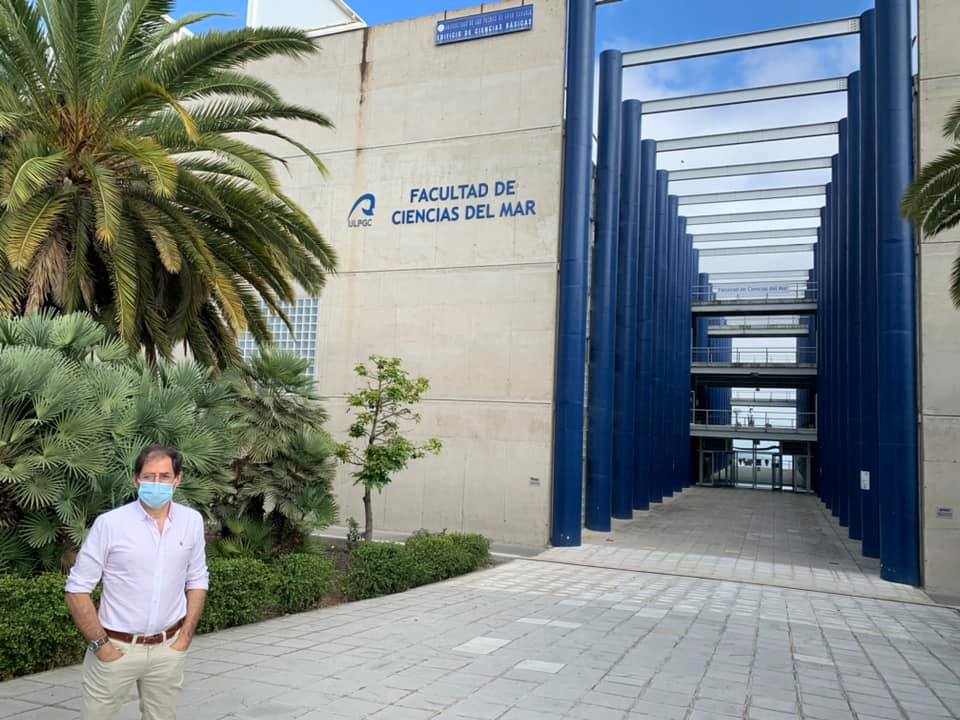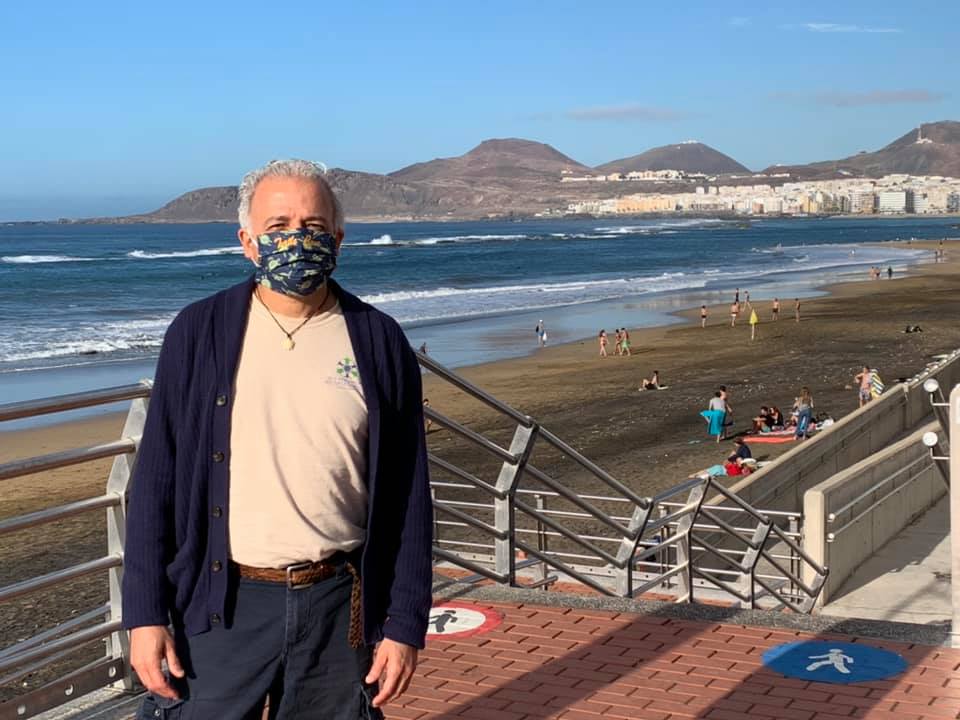Fulbright Report by Roldán A. Valverde, PhD
For many years, I dreamed of having the opportunity to represent my academic institution in an international program of some kind, Fulbright being my top choice. This dream arose from my love for diversity, in this case, for cultural diversity, to which my family expose me early on in life. Fortunately, I was granted my dream and I had the opportunity to spend an entire semester at Universidad de Las Palmas de Gran Canaria (ULPGC), Spain. In January of 2019, I begun the search for a Fulbright program that would fit my training and skills. At first, it was difficult because there was no clear roadmap to applying for a specific program. Fortunately, I had begun conversations with a couple of dear Spanish colleagues, one at the Oceanographic of Valencia and the other one at ULPGC a few years back. Looking through programs, I discovered that there was a short (4 months) program at ULPGC that would allow me to conduct research, as well as teach for a semester there. Because most Fulbright programs mainly have a teaching component, this hybrid program was perfect for me, as I thoroughly enjoy doing teaching and research. After putting together my application package, I finally applied in the summer of 2019 with the ULPGC at the center of my application. At the same time, I put in my application for a sabbatical leave at Southeastern for the same period of my Fulbright program application. The reason I wanted to go to the ULPGC program is that they have a captive group of Loggerhead sea turtles (Caretta caretta) that they have maintained since they brought them as eggs from their biological station at Cape Verde. This was perfect for me, since these animals would give me the opportunity to continue my studies on the reproductive physiology of sea turtles, but this time on animals for whom we knew their entire life history.

Indeed, this was a rare opportunity. I have to say though, that navigating another institution’s bureaucracy is not easy, especially from the distance. In this regard, I was most fortunate to have contacts inside the ULPGC, my dear colleagues Drs. Daniel Montero Vitores and Ana Liria Loza. After several months waiting for my Fulbright application to be resolved, I had the opportunity to visit in person the ULPGC program. Indeed, I was invited there by Dr. Montero to preside over the dissertation defense of one of his doctoral students, now Dr. Alejandro Usategui Marín.

As such, I traveled to the Canary Islands the last week of February of 2020. Although the original invitation was for only 3 days, I managed to squeeze in another couple of days for that trip. My visit there was simply outstanding as I got to sample the local cuisine and visit a few places in such a beautiful place. I was hooked! Amazingly, a week after my return from that trip I received an email notification from Fulbright: I had been awarded my scholarship for the 2020-2021 school year. I was extremely happy and thoroughly pleased with the news. During the summer and fall of 2020, I was busy complying with many more requests for information, attending orientation webinars, and planning in detail my experience. I was going to develop a new class in Marine Biology and then dedicate the rest of my time to show my colleagues how to conduct ultrasonographic scans and ELISA assays to measure blood concentration of reproductive hormones, such as testosterone and estrogen. For a few months, the entire program was touch and go because of the pandemic; I was personally fearful of a cancellation. Finally, the big day came: I flew to Spain in the middle of the pandemic in mid-January of 2021, before I had access to the COVID-19 vaccine. My flight took me first to Lisbon, where I had to wait for 11 hrs at the airport for my connecting flight; Lisbon was shut down due to the pandemic. By the time I got to the Canary Islands, I was exhausted. The first week I spend at a temporary apartment while I looked for a more permanent one.
Fortunately, I found one relatively cheap right on the beach walk in Las Canteras Beach, in the city of Las Palmas. The view was breathtaking, and I had to look at it every day, every time a came to the window, the entire time I was there. The ocean was beautiful; the beach was clean and with nearly white sand. One of the great pluses of that apartment is that it was embedded in the middle of the city, where I had quick access to essential services, like the bank, grocery stores, restaurants, etc. Nevertheless, quick access to the beach turned out to be a lifesaver, as I will mention later.

The semester at ULPGC started the first week of February. However, I was told that I was not going to be able to teach the class I had planned for, mostly because of the pandemic. Instead, they asked me to teach as invited guest one lecture in the graduate level course “Different Species Culture Techniques”, focused on sea turtles. This meant that I was to concentrate my effort while in Spain on my research, which actually worked out great for me. Accordingly, I spent most of my days locked up in my apartment, afraid of being exposed to the virus. Nevertheless, I was also very happy because I had finally plenty of time to dedicate my energy to tackling many papers I had on hold and on developing new collaborations. Every day I woke up, had breakfast and immediately got to work. I worked night and day on papers and in contacting potential collaborators in various parts of the world. In addition, I got the opportunity to work with the animals on which I had so much interest. We collected blood samples, ultrasounded the animals, and planned to conduct several projects in collaboration with my Spanish colleagues.

In fact, the only times I left my apartment was to go get groceries or to go work with the turtles. Early in my program, we were able to submit a paper for publication, which was quickly published in a peer review journal1. Currently, we have two other papers that we are about to submit for publication. In addition to this, my collaborator Dr. Liria and I were able to take a quick trip to Valencia, to visit Dr. José Luis Crespo Picazo, chief veterinarian of the Valencia Oceanographic to discuss with him a collaborative project between the Oceanographic, the ULPGC, and myself using the captive Loggerhead sea turtles kept at both institutions. The reason these turtles are so interesting endocrinologically speaking is that they are pubescent animals and there are no papers in the primary literature about this life stage from the reproductive physiology standpoint, my specialty. At the Oceanographic, I had the opportunity to give a seminar on the role of vitellogenin on the reproductive physiology of sea turtles, which was well received. I expect that the collaborative project we discussed will develop strongly over the next few years. Back in Las Palmas, life continued at a fast pace as I worked on more papers. In all, I was able to work on 8 papers. Currently, I continue to work on several other papers with collaborators in Costa Rica, Panama, Mexico and the US that I began while I was in Spain. I also was able to begin a few collaborative projects with colleagues in Japan, Israel, Mexico, Costa Rica and Panama, who have already collected blood samples for me to analyze. Unfortunately, the international sea turtle community is being impacted by a significant backlog of CITES2 import permit applications, and no one knows by when my application will be resolved. This will delay transfer of samples to my lab at Southeastern, which inevitably delay publication of my findings. Overall, all this represented a huge effort on my part.
Fortunately, about two months into my program I began to meet people. As it turns out, the Canary Islands are a significant destination for digital nomads from all over Europe. Via WhatsApp, I was able to connect with various groups that practice outdoor activities, such as hiking, Frisbee, volleyball, soccer, etc., all being hobbies of mine. This provided me with a huge relief from my professional activities and afforded me significant human contact with peoples of diverse cultures. Through these groups, I was able to come out to the beach several evenings every week to release steam and breathe fresh air. Among the memorable activities in which I engaged during my time in the Canary Islands was a hiking trip of almost 10 km to the summit of El Teide at 3,715 m (12,188 ft), the highest peak in Spain and 3rd highest volcano in the world. I have to say that the many friendships I created made it very difficult to leave the Canary Islands.

However, this experience fostered many long lasting prospects of collaboration with my colleagues and other institutions. We are now talking about me returning in about a year to ULPGC for the thesis defense of another doctoral student. In the meantime, our collaborative projects will continue to develop over the next few years. It is my hope and dream that all this work will result in bringing the international sea turtle symposium to Las Palmas in 3-4 years, a symposium I had the pleasure to preside over in New Orleans in 2014. Overall, this has been the most extraordinary professional and cultural experience of my life. Not only were the institutions involved amazing, but also the people I met in the Canary Islands were incredible. Moreover, the Canary Islands exhibit a landscape that is simply spectacular. I will remember this experience with most fondness for the rest of my life. My hope is that other faculty members of the Southeastern academic community learn from my experience and decide to participate in the wonderful and life changing Fulbright programs. To finalize this report, I am sharing a link to the Facebook album I created to document my experience: https://www.facebook.com/media/set/?set=a.10225267944632465&type=3.
I would like to thank the Fulbright Spanish Commission, in particular Clara Badimón and Katherine Matles for their incredible and constant support prior and during my stay in Spain. I also would like to thank the Fulbright US program and my institution Southeastern Louisiana University for awarding me such a tremendous experience.
1 Usategui‐Martín, A., Liria‐Loza, A., Valverde, R.A., Pinós‐Crosas, J., Tuya, F., Carbajal, A., López‐Bejar, M. and Montero, D., 2021. Assessment of captive rearing conditions on loggerhead hatchlings: Effect of handling frequency and stocking density. Journal of Experimental Zoology Part A: Ecological and Integrative Physiology.
2 CITES is the USFWS office in charge of issuing import permits of sea turtle samples.
Dr. Roldan Valverde, Fulbright Senior Scholar in 2021.
www.conserveturtles.org